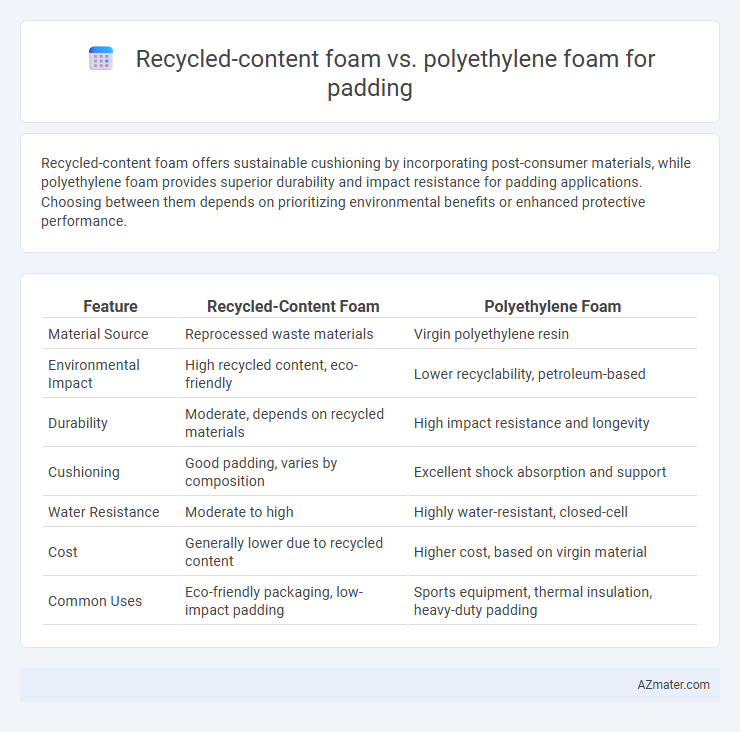Recycled-content foam offers sustainable cushioning by incorporating post-consumer materials, while polyethylene foam provides superior durability and impact resistance for padding applications. Choosing between them depends on prioritizing environmental benefits or enhanced protective performance.
Table of Comparison
| Feature | Recycled-Content Foam | Polyethylene Foam |
|---|---|---|
| Material Source | Reprocessed waste materials | Virgin polyethylene resin |
| Environmental Impact | High recycled content, eco-friendly | Lower recyclability, petroleum-based |
| Durability | Moderate, depends on recycled materials | High impact resistance and longevity |
| Cushioning | Good padding, varies by composition | Excellent shock absorption and support |
| Water Resistance | Moderate to high | Highly water-resistant, closed-cell |
| Cost | Generally lower due to recycled content | Higher cost, based on virgin material |
| Common Uses | Eco-friendly packaging, low-impact padding | Sports equipment, thermal insulation, heavy-duty padding |
Introduction to Foam Padding Materials
Recycled-content foam offers an eco-friendly alternative to traditional cushioning materials, incorporating post-consumer or post-industrial waste to reduce environmental impact. Polyethylene foam provides excellent durability, chemical resistance, and cushioning properties, making it a preferred choice for protective packaging and padding applications. Comparing their mechanical properties and environmental benefits helps determine the optimal foam padding material for specific use cases.
What is Recycled-Content Foam?
Recycled-content foam is a type of cushioning material made by incorporating post-consumer and post-industrial waste into the foam production process, reducing environmental impact and conserving resources. This foam maintains performance qualities such as durability and shock absorption while promoting sustainability compared to traditional polyethylene foam, which is typically made from virgin plastic materials. Selecting recycled-content foam for padding applications supports eco-friendly practices without compromising comfort or protection.
Understanding Polyethylene Foam
Polyethylene foam is a closed-cell, durable material known for its excellent cushioning, moisture resistance, and lightweight properties, making it ideal for padding applications. Its consistent density and shock-absorbing capabilities provide superior protection compared to recycled-content foam, which may vary in quality and performance due to mixed materials. Polyethylene foam's resilience and resistance to chemicals and temperature fluctuations optimize its effectiveness in industrial and packaging uses.
Environmental Impact Comparison
Recycled-content foam significantly reduces landfill waste by repurposing post-consumer materials, lowering the demand for virgin resources compared to polyethylene foam, which is typically derived from non-renewable petroleum. The manufacturing of recycled-content foam often generates fewer greenhouse gas emissions and consumes less energy than traditional polyethylene foam production. Furthermore, recycled-content foam enhances sustainability efforts by supporting circular economy principles, whereas polyethylene foam poses challenges in biodegradability and environmental persistence.
Performance and Durability Differences
Recycled-content foam often offers comparable cushioning and shock absorption to polyethylene foam but may vary in density and resilience based on recycled material quality. Polyethylene foam excels in durability, resisting compression set and maintaining performance over prolonged use in high-impact environments. While recycled foam emphasizes sustainability, polyethylene foam generally provides superior long-term structural integrity and consistent padding performance.
Cost Analysis: Recycled vs Polyethylene Foam
Recycled-content foam typically offers a lower material cost compared to polyethylene foam due to the use of repurposed raw materials, making it an economical choice for budget-conscious projects. Polyethylene foam, while generally more expensive, provides superior durability and resilience, potentially reducing long-term replacement expenses. Evaluating total cost requires balancing initial expenses with foam performance, lifespan, and specific application needs to determine the most cost-effective padding option.
Safety and Health Considerations
Recycled-content foam often contains fewer volatile organic compounds (VOCs) and harmful chemicals compared to traditional polyethylene foam, making it a safer choice for padding in terms of indoor air quality. Polyethylene foam, while durable and moisture-resistant, can emit low levels of VOCs and may pose challenges if not properly treated for fire retardancy and chemical stability. Prioritizing padding materials with certifications such as CertiPUR-US or GREENGUARD ensures reduced toxic emissions and better health outcomes in residential and commercial applications.
Suitability for Various Applications
Recycled-content foam offers an eco-friendly padding solution with good shock absorption, ideal for packaging fragile items and light cushioning in consumer products, while polyethylene foam excels in durability, moisture resistance, and impact protection, making it suitable for heavy-duty packaging, automotive components, and sports equipment. The thermal stability and chemical resistance of polyethylene foam provide superior performance in industrial settings, whereas recycled-content foam appeals to environmentally conscious sectors prioritizing sustainability. Selection between the two depends on specific application requirements such as load-bearing capacity, environmental impact, and exposure conditions.
Industry Trends and Innovations
Recycled-content foam is gaining traction in the padding industry due to its sustainability benefits and growing consumer demand for eco-friendly materials, with innovations focusing on improving durability and cushioning performance to match traditional foams. Polyethylene foam remains popular for its lightweight, high-impact resistance, and moisture-resistant properties, leading to advancements in closed-cell formulations that enhance thermal insulation and compressive strength. Industry trends show a shift toward hybrid solutions that blend recycled content with polyethylene to achieve optimal balance between environmental impact and functional performance.
Choosing the Right Foam for Your Needs
Recycled-content foam offers an eco-friendly option with decent cushioning and durability, ideal for sustainable packaging and crafts where environmental impact matters. Polyethylene foam provides superior impact resistance, moisture resistance, and long-term resilience, making it perfect for heavy-duty padding, shipping, and equipment protection. Selecting the right foam depends on balancing environmental priorities with the level of protection, compression resistance, and water exposure in your specific application.

Infographic: Recycled-content foam vs Polyethylene foam for Padding
 azmater.com
azmater.com